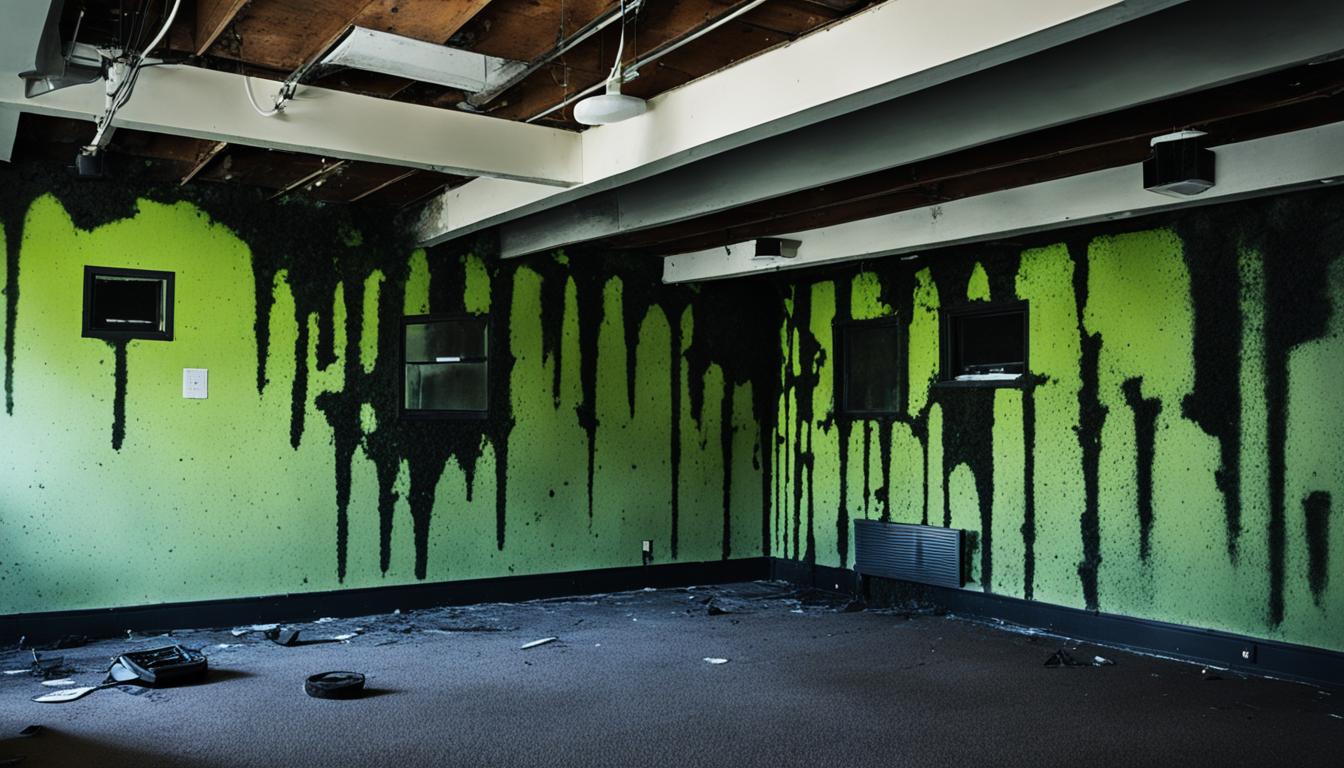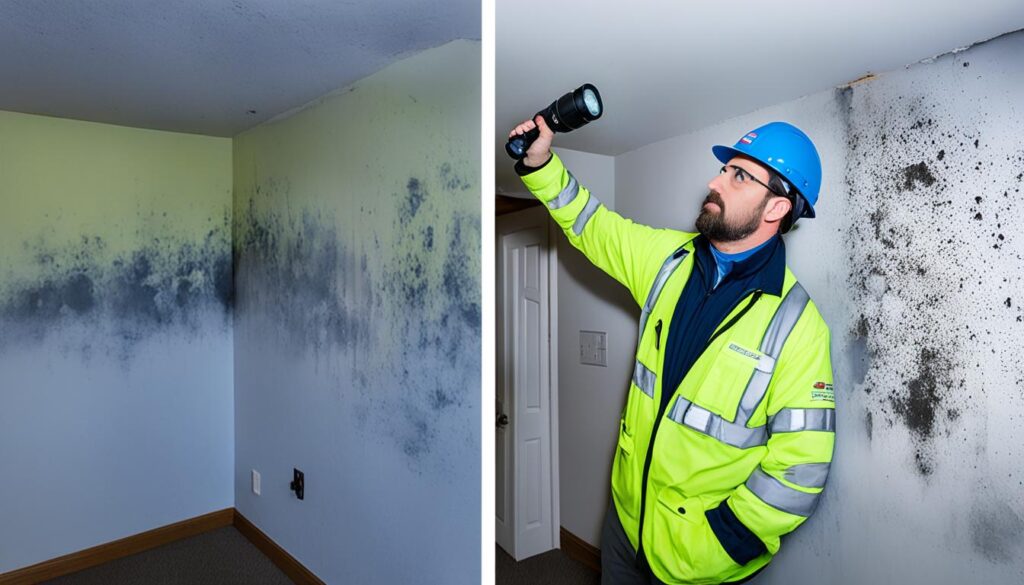
Mold in Building: Risks & Removal Guide
Welcome to the comprehensive guide on mold in buildings. In this article, we will explore the risks associated with mold growth in both residential and commercial buildings, and provide valuable insights on how to prevent and remove mold effectively. Mold can be a serious problem that affects indoor air quality and poses health hazards, so it’s important to address this issue promptly.
Key Takeaways:
- Mold in buildings can have adverse effects on indoor air quality and pose health risks.
- Preventing mold growth through proper ventilation and moisture control is crucial.
- Regular mold inspections and testing help identify and address mold issues early on.
- Prompt and effective mold removal is essential to prevent further damage.
- Contact Fix Mold Miami at 305-465-6653 for professional mold assessments, prevention, and remediation services.
Understanding the Hazards of Mold in Buildings
Mold growth in buildings can lead to serious health hazards and impact the overall indoor air quality. It is important to recognize the potential dangers associated with mold and take necessary steps to prevent and address it. In this section, we will delve into the risks of mold in buildings, focusing on both residential and commercial settings.
Health Risks and Indoor Air Quality
Mold can release spores into the air, which can be inhaled by occupants of the building. This exposure can trigger allergic reactions and respiratory issues, particularly in individuals with pre-existing conditions or compromised immune systems. Common health symptoms associated with mold exposure include:
- Respiratory problems
- Coughing and wheezing
- Skin irritation and rashes
- Nasal congestion
- Eye irritation
- Headaches
Proper inspection and maintenance of both residential and commercial buildings are crucial in order to maintain a healthy indoor environment. Identifying the presence of mold through building mold inspections is the first step in mitigating potential health hazards.
Residential Building Mold
Mold growth in residential buildings can be attributed to various factors such as excessive moisture, poor ventilation, and water leaks. Common areas where mold is often found in homes include basements, bathrooms, kitchens, and areas affected by water damage. Prompt detection and remediation are essential to safeguard the health of occupants and maintain the structural integrity of the building.
Commercial Building Mold
Commercial buildings, such as offices, retail spaces, and hotels, are not immune to mold growth. Factors such as HVAC systems, plumbing issues, and high humidity levels can contribute to mold problems in commercial settings. Besides the potential health risks to occupants, mold growth in commercial buildings can have a detrimental impact on business operations and reputation.
Identifying and addressing mold issues in commercial buildings requires specialized knowledge and expertise to ensure effective mold remediation without disrupting daily operations.
“Mold growth in buildings can impact the health of occupants and the overall indoor air quality.”

| Risks of Mold in Buildings | Residential Buildings | Commercial Buildings |
|---|---|---|
| Potential health hazards | Impact of excessive moisture | Common causes of mold growth |
| Indoor air quality concerns | Main areas of mold occurrence | Effects on business operations |
| Respiratory and allergic reactions | Prompt detection and remediation | Specialized remediation requirements |
Strategies for Mold Prevention, Inspection, and Remediation in Buildings
Mold can be a significant problem in buildings, posing risks to both the structure and the health of occupants. Preventing mold growth and addressing any existing mold issues are essential for maintaining a safe and healthy living or working environment. In this section, we will provide strategies and best practices for building mold prevention, inspection, and remediation.
1. Building Mold Testing and Inspection
Regular mold testing and inspection are crucial for identifying and addressing mold issues before they escalate. Here are some key steps to consider:
- Schedule routine mold inspections performed by certified professionals to detect any signs of mold growth.
- Use building mold testing methods, such as air sampling and surface swabbing, to assess the presence and concentration of mold spores.
- Inspect areas prone to moisture accumulation, such as basements, attics, bathrooms, and crawl spaces, for any signs of water damage, leaks, or dampness.
- Pay attention to musty odors, visible mold growth, or any unusual health symptoms experienced by occupants, as these could indicate a mold problem.
2. Mold Prevention Strategies
Preventing moisture buildup and creating an inhospitable environment for mold growth are key in mold prevention. Consider the following strategies:
- Control indoor humidity levels below 50% by using dehumidifiers or HVAC systems with proper moisture control capabilities.
- Ensure proper ventilation in high-moisture areas, such as bathrooms, kitchens, and laundry rooms, by using exhaust fans or opening windows.
- Repair any leaks or water damage promptly to prevent moisture from seeping into building materials.
- Insulate and properly seal windows, doors, and other potential entry points for moisture.
- Promptly address any plumbing issues, such as pipe leaks or condensation, to prevent water damage and mold growth.
3. Building Mold Cleanup and Remediation
If mold is detected, it’s crucial to take immediate action to prevent further damage and ensure the safe removal of mold. Use the following guidelines:
- Engage professional mold remediation services for larger mold infestations or when dealing with toxic mold species.
- Follow applicable health and safety guidelines during mold cleanup, including wearing protective equipment, containing the affected areas, and using proper ventilation and air filtration systems.
- Remove and replace mold-infested materials, such as drywall or carpeting, in severe cases where cleaning is not sufficient.
- Thoroughly clean and disinfect mold-affected surfaces with appropriate mold-killing solutions.
- Address the underlying cause of the mold growth, such as fixing water leaks or improving ventilation, to prevent future mold issues.
“Preventing and addressing mold issues in buildings requires a proactive approach, regular inspections, and prompt remediation. By implementing effective strategies for mold prevention, inspection, and cleanup, you can create a healthier and safer indoor environment.”
To learn more about building mold prevention, inspection, and remediation, contact Fix Mold Miami, Florida’s leading provider of mold assessments, prevention, and remediation services, at 305-465-6653.

Conclusion
In conclusion, addressing mold issues promptly and effectively in buildings is of utmost importance to safeguard the health and well-being of occupants. Throughout this article, we have explored the risks associated with mold in buildings and provided a comprehensive guide on how to prevent and remove mold from both residential and commercial settings.
Mold can have a significant impact on indoor air quality, leading to various health symptoms such as allergies, respiratory problems, and even more severe conditions. It is crucial for building owners and occupants to be aware of these hazards and take proactive measures to ensure a healthy living or working environment.
If you suspect mold growth in your building, it is recommended to seek professional assistance for mold inspection, testing, and remediation. By regularly inspecting for mold, implementing preventive measures, and promptly addressing any issues that arise, you can mitigate the risks associated with building mold and maintain a clean and safe space for all.
For expert assistance in Miami, Florida, Fix Mold is the highest-rated company offering comprehensive mold assessments, prevention, and remediation services. To learn more or schedule an appointment, contact Fix Mold Miami at 305-465-6653.




